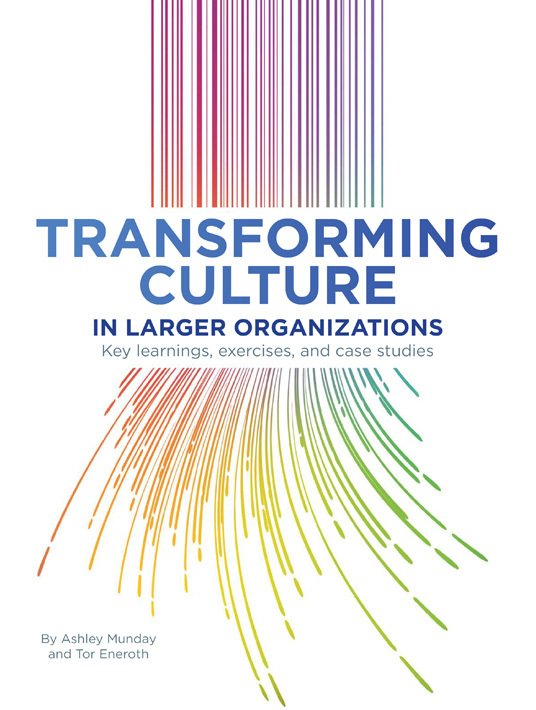Creating A High-Performing Culture: Key Success Factors
August 06, 2018
“How do we nurture the values on the factory floor in a meaningful way?” my client asked. It was a national supply chain management company. They had developed a solid leadership program to inculcate the culture and values among the top teams. The factory floor teams had only 15-minute standing meetings each day. Leadership didn’t want to “pull a Dilbert” and post lofty values on posters and wallet cards that weren’t connected to employees’ day-to-day experience. Together, we came up with a five-week strategy for each of the company values.

FREE EBOOK
Transforming Culture In Larger Organizations
Discover key learnings, smart exercises, and 3 great case studies that will help you identify your next steps in fostering a vibrant, high-performing work culture.
The first week, leaders came to share why the value was personally meaningful for them, and to share a story that illustrated how that value was lived. The second week, team members were asked to share what the value meant to them. They voluntarily shared their thoughts and beliefs about the value. The third week, the team members shared examples—without naming names—of how a particular value had not been lived at work. The fourth week, team members shared specific examples of how the value was lived at work.
Personal reflection and dialogue can significantly shift a team or organization to a high-performing culture. In this organization, the level of health measured in the culture went up after they implemented this process.
Every team culture is different. It takes reflection and dialogue to determine the best path forward. I have worked with organizational culture for over 10 years, and have identified these key success factors for high-performing culture.
Take time with your team to reflect on these together. Discuss what you do well and what you may need to consider or do differently going forward.
1. There’s Not One “Right” Model Of Corporate Culture.
Many of us are looking for the best, most effective, or most successful culture. There isn’t a model for what a corporate culture should be. In a time when companies are doing a great deal of benchmarking and many thought leaders are sharing insights, you must develop the right culture for your organization. Corporations are living systems.
Start by understanding:
- The mission, vision, and values of your organization
- Your personal needs and motivations
- The behaviors and actions needed to create the desired culture that supports your strategic ambitions
Keep in mind that culture is always changing in response to internal and external influences.
2. What You Measure, You Can Manage.
Even though there’s no prescription for a perfect culture, you will need to measure your unique cultureover time. It will be critical to track the impact of your initiatives and adjust your course.
3. Organizations Don’t Change; People Do.
You cannot expect your culture to change unless you are willing to transform yourself as a leader. This requires leadership development with an intimate understanding of who you are, how you behave, what is important to you, and, most importantly, what you need to find fulfillment in your life. When you are transparent about who you are, what you truly want, and what you find unacceptable, you will be seen as a person with integrity and will develop trust among your teams.
Cultural transformation must begin with authentic leaders who value human beings. When the top team leaders slow down to listen to the people in the organization and act upon those employees’ needs, transformation will begin. Many leaders are often too busy to listen to their own personal needs. They can also miss what is going on around them. Leaders at all levels need to continuously slow down and stay open to the needs of their employees.
It is important that leaders see themselves as a vital part of the whole and shift focus from self-interest to common good.
4. Start At The Top And The Bottom.
It is often said that culture change must start at the top, with the leadership. This is true, but not the whole truth. You also need to create programs and opportunities to involve employees in developing a high-performing culture. People naturally want to work for organizations that value their people and their culture. You can start in small groups within the organization to demonstrate the impact of culture change on team performance. For organization-wide change, however, you’ll need to empower leaders at all levels to live the desired culture.
5. Dialogue Is Key.
Culture is not like a machine that you construct and manage. It is more like a living plant that you must nurture. To cultivate this “living entity,” it is crucial to engage and involve people because they are the expression of your culture. The only way to achieve this is through dialogue or, even more precisely, through co-creative dialogue. Just by inviting dialogue you are starting your culture transformation. Through reflection and conversation, people develop a collective awareness of what’s functional and dysfunctional and begin to define the way forward toward the desired culture.
6. Transformation Takes Time.
As Stephen Covey is attributed as saying, “With people, slow is fast and fast is slow.” We live in a world where speed is revered. When it comes to culture, however, speed is not a success factor! This process involves human beings. Doing it too fast is like trying to jump from one side of the change curve to the other. It just does not work. If you try to push and go too quickly, your employees will be reluctant to act the next time you face change. So, instead of moving too fast, try investing time and being persistent and consistent.
These mindsets may seem obvious when reading, but can be more challenging to maintain day-to-day. As you set your intention and plan for nurturing your desired culture, you may want to revisit this list to see how your team has been doing. To read more about how to create a high-performing team and organization, download the eBook Transforming Culture In Larger Organizations. The lessons apply not only to organizations but for any teams.
This article was developed with contributions from Tor Eneroth at the Barrett Values Centre.
